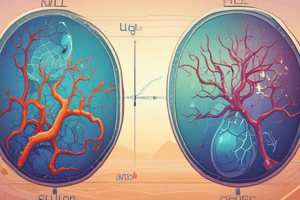Podcast
Questions and Answers
What is the primary purpose of respiration in an organism?
What is the primary purpose of respiration in an organism?
- To regulate the body's pH balance
- To facilitate the exchange of gases between the organism and its environment (correct)
- To produce energy through cellular respiration
- To control the contraction of respiratory muscles
Where are central chemoreceptors located in the body?
Where are central chemoreceptors located in the body?
- In the ventral surface of the medulla and retrotrapezoid nucleus (correct)
- In the lungs
- In the respiratory muscles
- In the ventral surface of the brain
What triggers the respiratory center in the brain to initiate contraction of the respiratory muscles?
What triggers the respiratory center in the brain to initiate contraction of the respiratory muscles?
- High levels of pH in the blood
- Low levels of hydrogen ions in the cerebrospinal fluid
- High levels of carbon dioxide in the brain (correct)
- Low levels of oxygen in the brain
What is the result of low levels of carbon dioxide in the brain and cerebrospinal fluid?
What is the result of low levels of carbon dioxide in the brain and cerebrospinal fluid?
What is the primary function of the respiratory muscles in the process of respiration?
What is the primary function of the respiratory muscles in the process of respiration?
What controls the depth of inspiration during breathing?
What controls the depth of inspiration during breathing?
What is the primary purpose of cellular respiration in organisms?
What is the primary purpose of cellular respiration in organisms?
Which component of the upper airway modulates patency for respiratory functions?
Which component of the upper airway modulates patency for respiratory functions?
Why is understanding the physiology of respiration crucial?
Why is understanding the physiology of respiration crucial?
What is essential for the delivery of oxygen to the body's cells and the removal of carbon dioxide?
What is essential for the delivery of oxygen to the body's cells and the removal of carbon dioxide?
Flashcards are hidden until you start studying
Study Notes
The Physiology and Mechanisms of Respiration
Respiration, often referred to as breathing, is the physiological process that facilitates the exchange of gases between an organism and its environment, primarily by inhaling oxygen and exhaling carbon dioxide. This process is crucial for life, as it enables the delivery of oxygen to the body's cells, which in turn allows for the production of energy through cellular respiration. Respiration is regulated by a complex system involving neural control, sensory input, respiratory muscles, and the lungs.
Central Chemoreceptors
Central chemoreceptors are located in the ventral surface of the medulla and retrotrapezoid nucleus. They are responsible for detecting changes in the concentration of oxygen, or oxygen partial pressure, and carbon dioxide, or carbon dioxide partial pressure, in the brain and cerebrospinal fluid. An acidic environment, which is indicative of high levels of carbon dioxide, triggers the respiratory center in the brain to initiate contraction of the respiratory muscles, thereby increasing the rate and depth of ventilation to expel more carbon dioxide and restore a healthy pH balance. Conversely, low levels of carbon dioxide result in low levels of hydrogen ions, leading to a decrease in the rate and depth of ventilation and slowing of breathing.
Respiratory Muscles and Lungs
Information from neural and sensory input systems signals to the diaphragm and other respiratory muscles, allowing for control of ventilation. The upper airway, composed of soft tissues, muscles, and bony structures, modulates patency for respiratory functions. The depth of inspiration during breathing is based on the level of activity of the respiratory center in the brain, with more stimulation resulting in increased motor unit activation and greater force from respiratory muscles.
Cellular Respiration
Cellular respiration is the process by which an organism extracts energy from food, primarily through the consumption of oxygen and the release of carbon dioxide. This process evolves after photosynthesizing organisms provide a steady source of oxygen, which became abundant in the Earth's atmosphere and is used by most organisms on land, freshwater, and the oceans for growth, reproduction, and other functions.
Conclusion
Respiration plays a vital role in the maintenance of life by facilitating gas exchange and enabling cellular respiration. It is a complex process regulated by neural control, sensory input, muscles, and the lungs, and is essential for the delivery of oxygen to the body's cells and the removal of carbon dioxide. Understanding the physiology of respiration is crucial for managing conditions that may affect respiratory function, such as chronic pain, obstructive sleep apnea, or the use of central nervous system depressants that can suppress respiratory processes.
Studying That Suits You
Use AI to generate personalized quizzes and flashcards to suit your learning preferences.



